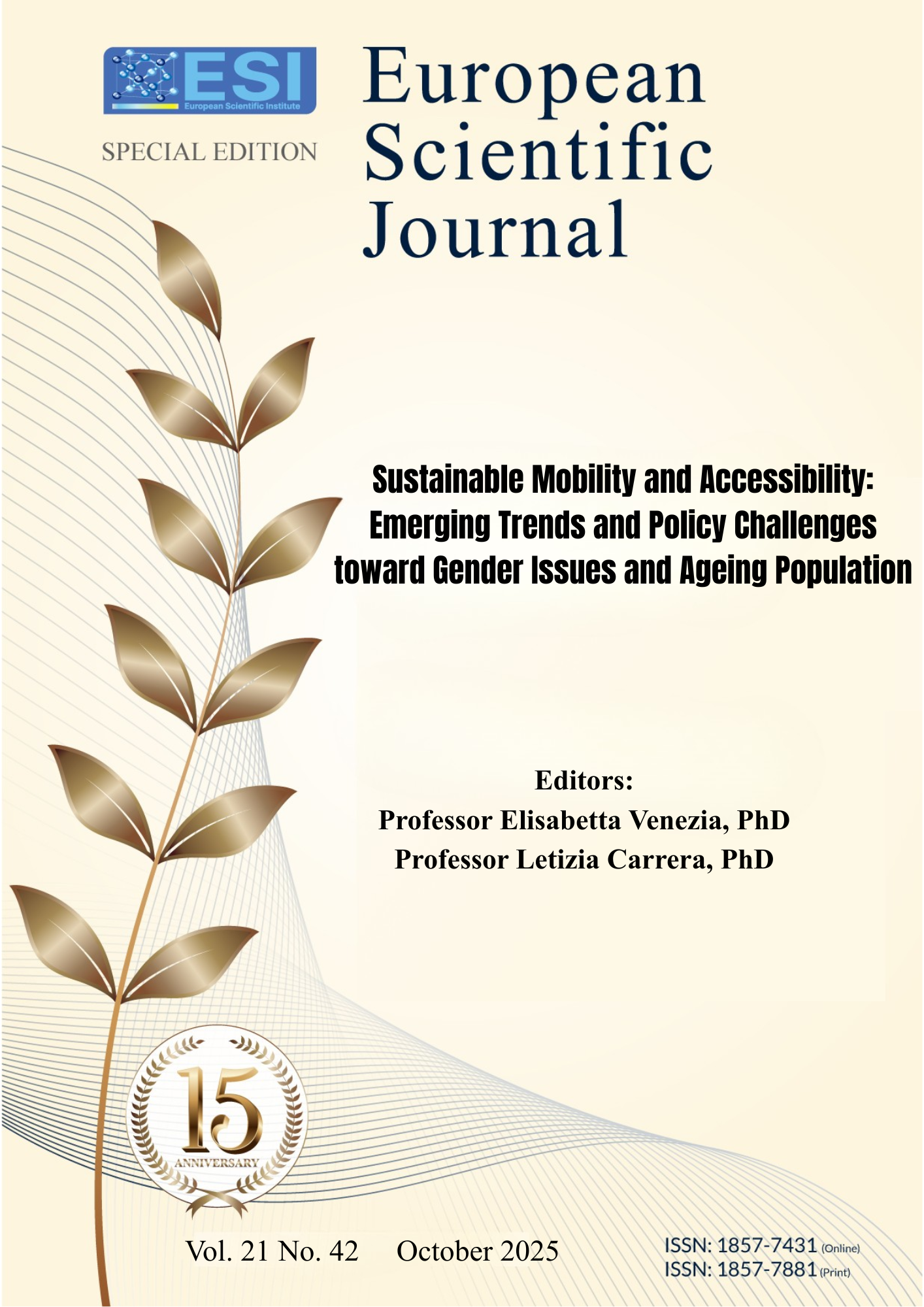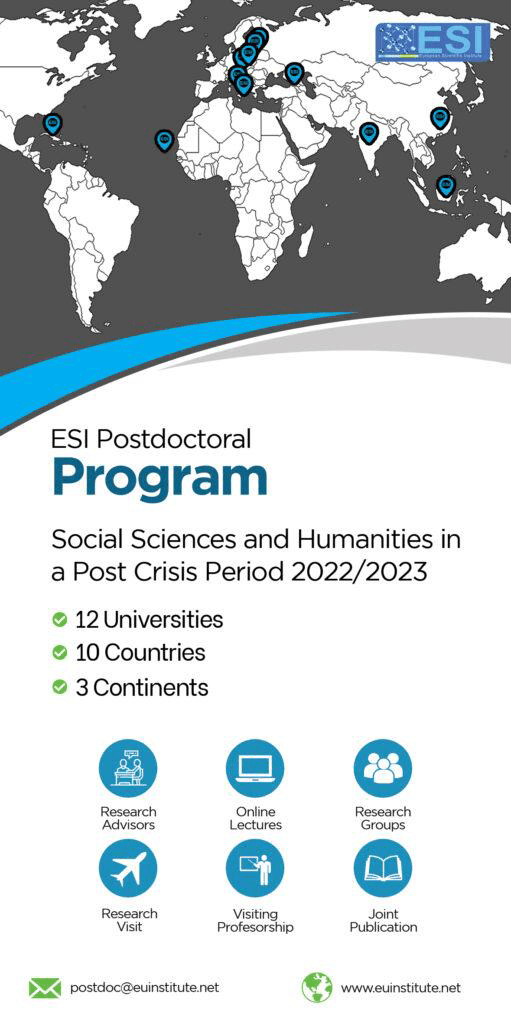The Right to Walkability for Older Citizens in Age-Friendly Cities: “Let’s Move Through the City” an Explorative Qualitative Survey
Abstract
This article aims to explore the role of the right to walkability for older adults within the broader goal of developing age-friendly cities, with a focus on the intersection of urban policy and tactical urbanism. In light of Italy’s demographic ageing and shifting urban dynamics, the study investigates how cities can support pedestrian mobility for older populations by improving walkability, understood as one of the key indicator of health, autonomy, and social inclusion. The article outlines how tactical urbanism, characterized by low-cost, temporary, and community-driven interventions, can complement institutional planning efforts and foster more accessible, inclusive public spaces. Drawing on qualitative research conducted in Bari’s metropolitan area in late 2024, which included 86 interviews with people over 65, the study identifies four typologies of urban walkers and highlights how the local urban environment significantly affects older adults’ mobility and perceived well-being. The findings emphasize the need for participatory approaches and localized interventions that address physical, social, and psychological barriers to walkability. The article concludes by advocating for integrated strategies that recognize older citizens as active participants in shaping urban space, positioning walkability as both a practical and symbolic component of inclusive urban futures.
Downloads
Metrics
PlumX Statistics
References
2. Amendola, G. (a cura di). (2009). Il progettista riflessivo: Scienze sociali e progettazione architettonica. Roma–Bari: Laterza.
3. Ariffin, R. N. R., Zahari, R. K., & Yusof, H. M. (2021). Systematic literature review of walkability and the built environment. IOP Conference Series: Earth and Environmental Science, 716,
4. Billari, F. C. (2023). Domani è oggi: costruire il futuro con le lenti della demografia. Milano: Egea.
5. Bishop, P., & Williams, L. (2012). The Temporary City. Abingdon: Routledge.
6. Carrera L. (2025). Women’s Wise Walkshops. The feminist Perspectives in Reimagining the City. Fuori Luogo (forthcoming)
7. Carrera, L. (2016). Vedere la città. Gli sguardi del camminare. Milano: FrancoAngeli.
8. Carrera, L. (2022). La flâneuse. Sguardi ed esperienze al femminile. Milano: FrancoAngeli.
9. Carrera, L. (a cura di). (2024). Sguardi diversi. Riflessioni, analisi, immagini, pratiche. Bari: Progedit.
10. Carrera, L. (2025). Age Friendly Cities. Progettare lo spazio urbano come luogo di benessere. In Salute e Società, XXIV, 2/2025, pp.20-35.
11. Colleoni, M., Daconto, L., & Caiello, S. (2024). Quality of the walkability for measuring accessibility: The case of the elderly people in the city of Milan. In P. Pucci & G. Vecchio (Eds.), Questioning Proximity – Opportunities and Challenges for Urban Planning and Mobility Policies (pp. 31–41). Cham: Springer.
12. Colleoni, M., Caiello, S., & Daconto, L. (2017). Walkability e accessibilità urbana. In Focus su mobilità pedonale in città, XIII Rapporto Qualità dell’Ambiente Urbano (ISPRA).
13. Davis, M. (1999). Geografie della paura. Los Angeles: l’immaginario collettivo del disastro. Milano: Feltrinelli.
14. De Carlo, G. (2015). L’architettura della partecipazione (S. Marini, a cura di). Macerata: Quodlibet.
15. DeMersseman, A., Dickman, D., Key, N.-T., Spidell, L., & Wright, S. (2009). 20 Minutes in West Portland Park: Opportunities for Access. Workshop Project, Portland State University.
16. Denzin, N. K., & Lincoln, Y. S. (2018). The SAGE Handbook of Qualitative Research (5th ed.). SAGE Publications.
17. Dioguardi, G., Carrera, L., & Maggiore, F. (Eds.). (2022). City School Bari per il governo della città complessa: Studi promossi dalla Sum City School of urban management. Milano: FrancoAngeli.
18. Dovey, K., & Pafka, E. (2020). What is walkability? The urban DMA. Urban Studies, 57(1), 93–108.
19. Edwards, M. B., Whittington, N., Mack, D., & Ussery, K. (2024). Assessing older adults’ walkability in the surroundings of primary health care areas, Barcelona. Sustainability, 17(15), Ewing, R., & Handy, S. (2009). Measuring the unmeasurable: Urban design qualities related to walkability. Journal of Urban Design, 14(1), 65–84.
20. Zhao G, Cao M., De Vos J.,. 2024. Exploring walking behaviour and perceived walkability of older adults in London. Journal of Transport & Health. Volume 37.
21. Hadley, S., & Belfiore, E. (2018). Cultural democracy and cultural policy. Cultural Trends, 27(3), 218–223.
22. Honey-Rosés, J. (2023). Barcelona’s Superblocks as Spaces for Research and Experimentation. The Journal of Public Space, 8(2), 1–20.
23. Istat, Rapporto 2021, Le condizioni di salute della popolazione anziana in Italia.
24. Jessoula, M., & Pavolini, E. (Eds.). (2022). La mano invisibile dello stato sociale: Il welfare fiscale in Italia. Bologna: Il Mulino.
25. Kvale, S., & Brinkmann, S. (2015). InterViews: Learning the Craft of Qualitative Research Interviewing (3rd ed.). SAGE Publications.
26. Lefebvre, H. (1968). Le droit à la ville. Paris: Éditions Anthropos.
27. Lydon, M., & Garcia, A. (2015). Tactical Urbanism: Short-Term Action for Long-Term Change. Washington, DC: Island Press.
28. Martire, F., Parra Saiani, P., & Cataldi, S. (2023). La ricerca sociale e le sue pratiche. Roma: Carocci Editore.
29. Pavolini, E. (2004). Regioni e politiche sociali per gli anziani. Le sfide della non autosufficienza. Roma: Carocci.
30. Ranci, C. (2001). Il mercato sociale dei servizi alla persona. Roma: Carocci Editore.
31. Sen, A. (1992). Inequality Reexamined. Oxford: Clarendon Press.
32. Sen, A., & Nussbaum, M. (1993). The quality of life. In The Quality of Life. Oxford University Press.Silverman, D. (2017). Doing Qualitative Research (5th ed.). SAGE Publications.
33. Simon, C. (2022). Portland’s 20 Minute Neighborhoods after Ten Years: How a Planning Initiative Impacted Accessibility (Master’s thesis). University of Washington.
34. Speck, J. (2012). Walkable city: How downtown can save America, one step at a time. Farrar, Straus and Giroux.
35. Thrift, N. (2006). Space. Theory, Culture & Society, 23(2–3), 139–146.
36. Van Hoof, J., Kazak, J. K., Perek Białas, J. M., & Peek, S. T. M. (2018). The Challenges of Urban Ageing: Making Cities Age Friendly in Europe. International Journal of Environmental Research and Public Health, 15(11), 2473
37. Venerandi, A., Pettit, C., Chandra, S., & Lieske, S. N. (2024). Walkability indices - The state of the art and future directions: A systematic review. Sustainability, 16(16), 6730.
38. Westenhöfer J, Nouri E, Reschke ML, Seebach F, Buchcik J. Walkability and urban built environments-a systematic review of health impact assessments (HIA). BMC Public Health. 2023 Mar 17;23(1):518.
Copyright (c) 2025 Letizia Carrera

This work is licensed under a Creative Commons Attribution 4.0 International License.








